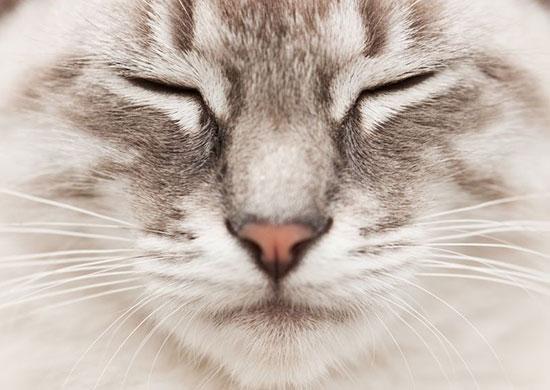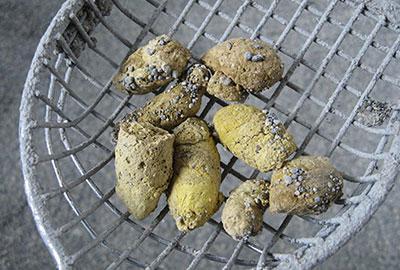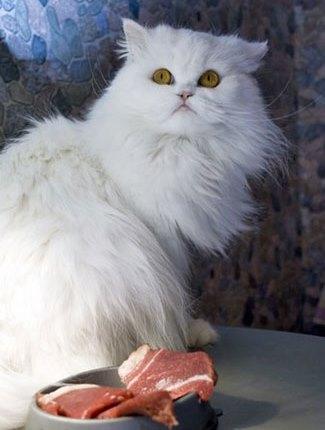This content is archived from the Feline Nutrition Foundation
Constipation: Real Help for Your Cat
- Updated: Friday, May 24, 2019 01:39 PM
- Published: Saturday, March 14, 2015 12:12 PM
- Written by Natascha Wille
 One of the immediate results when feeding kitty a raw cat food diet is less cat poop, and cat poop that smells less. While some owners welcome this change, others are concerned that their cats might be constipated.
One of the immediate results when feeding kitty a raw cat food diet is less cat poop, and cat poop that smells less. While some owners welcome this change, others are concerned that their cats might be constipated.
Feeding a raw cat food diet can closely resemble nutritionally what cats would eat if living wild, but, despite our best efforts, it is not a truly natural diet. That can only be replicated by feeding small whole prey. One of the biggest differences between raw cat food and a prey-based diet is fur. Fur, ingested with prey, has no nutritional function, but serves two key mechanical functions which we lack when feeding homemade cat food. First, by action of the cat biting down on small prey, the fur of the prey is brushing against the teeth, helping to wipe away plaque and preventing accumulation of tartar. Second, fur has an important role as a non-irritating stool bulker.
Unfortunately, fur is next to impossible to substitute in a raw meat diet, because adding hair or fur to a recipe would be difficult. Instead, people resort to a number of ingredients from plant origin to fulfill this need. The cereals, potatoes, peas, and beet pulp in commercial pet foods not only are intended as a source of inexpensive calories and for texture, but also serve to bulk stool. The same goes for vegetables and fiber supplements in homemade cat food recipes. But, fur is protein, while stool bulkers from plant sources are cellulose and starch based. Cellulose and starch are fermented in the lower digestive tract by different bacteria than fur would be, and this can cause problems. Trouble may arise right from the start when cats are reluctant to eat a food filled with vegetables or fiber supplements or when they regurgitate the food because of it.
Is your cat really constipated? What some cat owners observe as constipation isn't really a problem. Perhaps it is a trademark of an animal that is native to a mostly semi-arid climate. Having evolved in the dry climate of Africa and the Near East, cats are superbly equipped to conserve water. They do not sweat and rarely pant; they concentrate their urine to a high degree and extract all possible fluids from feces before it leaves their body. They are so efficient in conserving water that they can exist on the fluids provided by eating prey alone. Their feces will naturally be very firm, pellet-like, dry, and off-white or with a yellow tint. The feces will be crumbly, held together largely by hair – cat hair and that of prey.
Constipation includes infrequent bowel movements, typically three times or fewer per week, incomplete bowel evacuation and difficulty during defecation due to hard, dry stool, causing straining during more than 25% of bowel movements, the cause of which is a slow transit time. Transit time is the time which elapses from when food is ingested to its excretion in the form of stool.
 If your cats' feces look similar to this image, all could be well, but it's possibly not what you thought the feces of cats should look like. The feces pictured are similar to what I see in my own raw fed cats. My attempts to change the appearance of the feces by addition or omission of ingredients have been unsuccessful. As a result, my cats produce small, dry feces and often only a few times per week. Over the past 20 years that has simply not led to any problems in my cats. Based on the description of what constipation is, my cats would be considered constipated. Be sure your cat is having a problem before you treat for constipation. Cats eating raw food typically have dry feces; this alone does not mean the cat is constipated.
If your cats' feces look similar to this image, all could be well, but it's possibly not what you thought the feces of cats should look like. The feces pictured are similar to what I see in my own raw fed cats. My attempts to change the appearance of the feces by addition or omission of ingredients have been unsuccessful. As a result, my cats produce small, dry feces and often only a few times per week. Over the past 20 years that has simply not led to any problems in my cats. Based on the description of what constipation is, my cats would be considered constipated. Be sure your cat is having a problem before you treat for constipation. Cats eating raw food typically have dry feces; this alone does not mean the cat is constipated.
However, some cats have a real problem with constipation. Restlessness, lack of appetite, vomiting, and frequent trips to the litterbox to defecate without results requires veterinary attention. A veterinarian will help to diagnose its cause and find an appropriate solution, because constipation is not always diet-related. To relieve the acute condition, a veterinarian will administer an enema and prescribe medication and laxatives.
To help prevent constipation, there are various methods you can try. Some might be successful; others only in the short term; some might be of no benefit at all. Interestingly, some of the successful methods are often effective for only some time, until cats have dry, infrequent bowel movements once again despite it.
Stool volume and frequency of bowel movements increase as the portion of indigestible matter in food is raised. Large, frequent bowel movements indicate that the food eaten is largely indigestible, and little of it is being utilized. If it is desirable to increase fecal output, the order of the day must be to increase the content of indigestible matter (filler) in the food. Commercial dry foods, for example, produce bowel movements of unnaturally large size, loose texture, intolerable odor and high frequency due to the high content of ingredients of poor nutritional value.
Water. Adding more water to the diet in hope of making feces softer does not work. Cats' physiology is such that they naturally extract as much moisture from feces as possible before voiding them. Adding water to food will increase urine output, but reduce food intake, because the same volume of food now contains more moisture. Reduced food intake will result in fewer feces and makes constipation worse.
Increased food intake. I have observed that kittens are rarely constipated. Every day they void nice feces on the raw food. Compared to adult cats, kittens consume proportionally much more food to support their daily energy requirements and support growth. Active cats that eat more food to support the energy requirement of their lifestyle also have larger and more frequent bowel movements. Simply put, food volume translates into fecal volume. Increased food intake signals more frequent emptying of the bowel before feces become excessively desiccated in the colon which perpetuates the constipation problem. Inactive cats that just nibble on their food instead of eating it with gusto are prone to constipation. It is important to increase palatability of the food to assure that cats eat a healthy portion at each feeding.
Cat hair. If the fur of prey is an ideal stool bulker, then cat hair is a second best. Cats will naturally ingest a lot of their own hair during grooming, and this should not be discouraged. Excessive brushing and bathing may leave your cat short on laxatives! Cat hair should pass through the entire alimentary tract without causing any concern. Healthy cats eating raw food regurgitate almost no hair balls. If cats frequently regurgitate hairballs, crave eating grass and bring food back up, then something is wrong.
Bone. The feeding of raw bones or bone meal has been linked to constipation. There are two sides to feeding bones, however. Calcium in bone is present as calcium phosphate. An excess of calcium in the diet can contribute to constipation. But bones are not entirely made of calcium phosphate or minerals. Bones are mostly a dense protein matrix in which mineral stores are laid down to give bone rigidity, also serving the body as a reserve of minerals. This protein matrix of bone isn't unlike fur. It is largely indigestible and as a result bulks stool. Undigested bone in feces looks like crumbly lime.
Magnesium. Calcium can contribute to constipation, while magnesium may be used to relieve it. Magnesium has many functions in the body, including buffering stomach acid and moving stool through the intestines. As an essential mineral it must be present in the diet in sufficient amounts, but due to its connection to urinary struvite crystals, many diets for cats are low in magnesium. Some cases of constipation could, therefore, be a magnesium deficiency. A larger dose of magnesium can be used therapeutically as a laxative. The laxative property of magnesium has two mechanisms. Magnesium is essential for proper muscle function in that it aids in muscle relaxation in general, but is also responsible for a smooth rhythm of the intestines. Magnesium also attracts water, increasing the amount of water in the colon to help soften the stool.
Raw liver and fat. Raw liver can act like a mild laxative. Increasing the fat content of the meat used to make the diet can encourage a faster transit time of matter through the digestive tract and more frequent emptying of the bowel. Mild-flavored vegetable oil like canola or sunflower oil can be added to the food as well or instead of using fattier meats. Some cats really enjoy olive oil and will lap it up pure. Vegetable fats are not as easily digested by the cat and may help hasten things along in a similar manner as oral petroleum jelly remedies would.
Pumpkin. By far one of the most popular remedies for constipation in cats by veterinarians and owners alike is inclusion of pure canned pumpkin to the diet. Results are mixed. According to data by the USDA, canned pumpkin is 90% moisture and 2.8% fiber. With each tablespoon of canned pumpkin mixed into a portion of cat food, mostly water and little fiber is added. This means that canned pumpkin is not a stool bulker, but must have other laxative effects. I have heard that canned pumpkin has short-lived effects, however. Cats appear to get accustomed to it, and feces return to being small, dry, and infrequent. Although canned pumpkin is accepted by many cats, some cats will not eat food in which it is included.
Another method of adding pumpkin to the diet is to create a vegetable mix with butter. For that, 450g (2 cups) canned pumpkin is heated and 220g (1 cup) butter is melted and blended into the warm pumpkin. This is then added to a recipe of raw cat food using 900g (2 pounds) raw meat and 100g (3.5 ounces) raw liver. Before serving, it is best to warm this type of food. The butter increases the fat content of the diet, which can encourage a faster transit time of matter through the digestive tract and it also increases palatability. Alternatively, and perhaps preferably, steam-cooked and pureed yam or butternut squash can be used instead of canned pumpkin.
 Vegetables. I cannot truly recommend the addition of any vegetables to the diet of cats. If vegetables are to be included as an aid in helping to prevent constipation, I would have a preference to using cooked or canned pumpkin, squash or yam as described above. Some cats do appear to have a liking for canned peas and chick peas, and, perhaps, including them in the diet, pureed, is helpful for some cats. I hear that some owners like feeding pureed vegetable baby food from jars. Be careful that any baby foods you use do not contain onions or garlic.
Vegetables. I cannot truly recommend the addition of any vegetables to the diet of cats. If vegetables are to be included as an aid in helping to prevent constipation, I would have a preference to using cooked or canned pumpkin, squash or yam as described above. Some cats do appear to have a liking for canned peas and chick peas, and, perhaps, including them in the diet, pureed, is helpful for some cats. I hear that some owners like feeding pureed vegetable baby food from jars. Be careful that any baby foods you use do not contain onions or garlic.
Ground sunflower seeds. Sunflower seeds represent an interesting solution to help bulk stool. They are mild in flavor and practically indigestible for cats, which means that they pass through the alimentary tract fairly unchanged. They can be ground into a powder with the help of an electric coffee bean grinder. Twenty years ago, when I began formulating my raw food for cats, I included them successfully as part of a seed and nut mix which attempted to mimic the stomach content of a mouse.
Ground flax seeds. Flax seeds are a popular fiber supplement for people. Their mild and nutty flavor may make them suitable for use in cats to bulk stool. But, use raw flax with caution. All raw flax seeds contain cyanogenic glycosides which release toxic hydrogen cyanide in the presence of water. The longer raw flax seeds sit in water or in raw cat food, the greater the concentration of toxins. Boiling the flax seeds neutralizes the toxin. They are best finely ground, or use a defatted flax fiber supplement. Remember to boil all flax products before including them in raw cat food. Flax boiled in water creates a gelatinous texture that creates an overall pleasing food texture and may aid in increasing moisture of feces.
Psyllium husk. Psyllium husk, also sold as the popular brand Metamucil®, is a well-known remedy for preventing constipation in humans. It is also used by veterinarians and cat owners for cats with constipation. Its effectiveness may be short lived, however. It appears that with long term inclusion of psyllium husk in the diet of cats, the remedy loses its effectiveness. It is, therefore, better used as a short-term therapeutic remedy. Cellulose gums have a similar function and in a similar way lose their effectiveness if used long term.
Bran. Bran is a well-known source of fiber from wheat, oats or rice. Wheat and rice bran are not very palatable. Oat bran is high in starch. Personally, I would not subject my cats to any form of bran for fear of causing undue discomfort like regurgitation, vomiting, gas or diarrhea.
Do cats need a source of plant fiber in their diet? It is not considered essential for simple stomach carnivorous mammals like cats. As part of their natural prey diet, cats do not ingest dietary plant fiber and their digestion requires no substrate or medium for food fermenting bacteria to live on. Plant fiber plays an important role in the diet of omnivores, and is essential in the diet of herbivores which exist largely on byproducts created by bacterial fermentation of cellulose fiber, but cats as obligate carnivores have no natural need for plant fiber.
Introducing plant fiber or starches into the digestive tract of cats means creating a habitat for bacteria which might otherwise not multiply there or be part of the natural gut flora. When these bacteria proliferate and begin to ferment the fiber and starches, they create gases which not only can be very uncomfortable for cats, but also toxic and cause inflammation. Inflammation of the intestines will then result in loose stool or diarrhea. Inclusion of plant-based fibers and starches in the diets of cats needs to be approached with caution; cats need to be observed for regurgitation, excessive gas or irritation to the lower digestive tract resulting in loose stool or diarrhea. High levels of fiber from excessive inclusion of foods or supplements from plant source can depress digestibility of nutrients and displace them. Sometimes, the cause of constipation is not related to the diet or lack of bulk in the diet, in which case adding fiber will not promote stool bulking and more frequent bowel movements.
Additional Reading
Answers: Raw Food for Cats, What About Eating Bones?
Answers: Kittens Go Through Teething, Too
Cats with a tendency to regurgitate their food should not be given fiber even when constipated, because fiber supplements or the addition of vegetables may increase the frequency of regurgitation. Cats that regurgitate food should be fed several small meals of highly-digestible food throughout the day. They should not have essential nutrients and calories replaced by bulk in their diet. Constipation in these cats may simply be the result of a lack of food volume passing through the digestive tract. Consistent, small meals throughout the day of highly-digestible food should soon remedy this while, with the help of a veterinarian, the underlying cause of the repeated regurgitation of food is being investigated.
Natascha Wille has used a homemade raw meat diet to feed her cats for twenty years. With the help of her large study group of cats, she created one of the most popular raw cat food recipes in use today worldwide. She is the innovator behind the raw cat food premixTCfeline, which has helped many cat owners realize raw feeding since 1998. TCfeline is made in Canada and the U.S. and made in Germany for the E.U.




